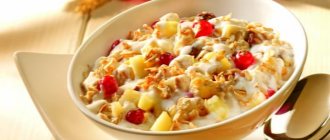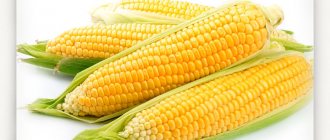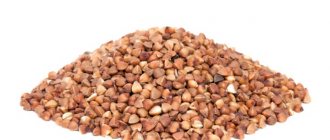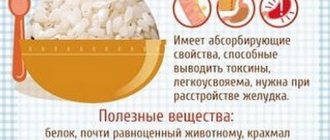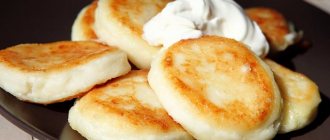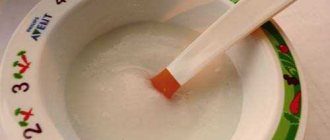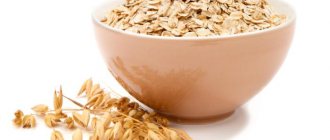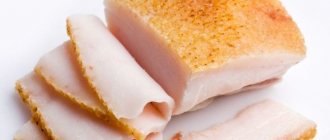During breastfeeding, mother and baby eat together. Any food eaten by a woman, to one degree or another, enters the child’s body with milk. Therefore, the issue of regulating your own diet comes to the fore. Porridge is the safest food product for a nursing woman, and each is characterized by individual beneficial properties and a special effect on the body (be it buckwheat, oatmeal, corn, wheat, barley). Let's consider how useful corn porridge is for breastfeeding, how to prepare it correctly, and whether there are any contraindications.
Nutrition in the first months
The newborn’s digestive system is still developing; unfamiliar foods in the mother’s diet can trigger allergies and all sorts of disorders. Even regular corn porridge is not suitable for everyone when breastfeeding. That is why in the first months a diet and a strictly limited range of products are recommended. From about three months of age, you can gradually return to your usual food.
But this does not mean that now you can eat absolutely everything. Nothing spicy, smoked, salty. There is also a minimum of preservatives and products that cause fermentation in the intestines. Eating fruits and vegetables is possible, but only after heat treatment and in small quantities. When introducing a new product, you should monitor the baby’s reaction. If everything is normal, you can continue to eat it; if not, exclude it for a while.
Porridge while breastfeeding
A woman’s nutrition during breastfeeding deserves special attention. Products must be chosen carefully, prepared correctly, and consumed in moderation. It is important that mommy has a complete and balanced diet. An ideal side dish, as well as an independent dish, is porridge.
They become the main source of complex carbohydrates and provide energy. Depending on the type of cereal, each porridge contains a certain set of micronutrients. Fiber, present in large quantities, regulates intestinal function. B vitamins affect the functioning of the nervous system. Vitamin E improves the condition of bone tissue and epidermis.
Calcium along with vitamin D is extremely important for nursing mothers.
You can start eating most cereals while breastfeeding already in the first month. They are introduced into the child’s diet no earlier than after six months. If the baby is gaining weight well, then complementary feeding begins with vegetables, and porridge is given for the first time at 7-9 months.
Rice
You can eat rice porridge from the first days of breastfeeding. The cereal does not contain gluten and is not capable of causing skin reactions in a child. However, it may affect stool.
If the baby has problems with bowel movements or the mother has postpartum constipation, it is not recommended to eat this dish during breastfeeding. When digestion is restored, you can use it up to 2 times a week.
Rice porridge is useful because it is a good antioxidant and performs a fixing function. It contains vitamins H, E and B, and also contains phosphorus, sulfur and magnesium.
Wheat
This cereal contains gluten. If a child has an intolerance to this substance, then it is impossible to eat wheat porridge during breastfeeding. This product should be introduced into the diet no earlier than a month after birth.
On the first day, you can eat up to 20 grams of ready-made porridge, after which you take a break for a day and, if there are no negative reactions from the child’s body, double the dose. The benefit of wheat porridge lies in its rich composition.
There are vitamins of group B, PP, E, zinc, potassium, magnesium, calcium, iodine.
Corn
The absence of gluten in corn porridge allows a woman to try it immediately after giving birth. Experts allow you to eat it at least every day if there are no stomach problems. Corn porridge on breastfeeding normalizes the intestinal function of a woman and her baby. The product is useful because it contains vitamins A, E, C, supplemented with calcium, phosphorus and magnesium.
Manna
Often women doubt whether it is possible to eat semolina while breastfeeding. There is no clear answer from experts here. Such a dish is considered “empty”.
Semolina porridge is recognized as a nutritious product with a pleasant taste, but it has no benefits. The presence of gluten in semolina can cause a reaction in a child.
Despite the fact that the cereal contains calcium, it is not absorbed in the body due to phytin, which is also found in crumbly cereal.
Semolina does not have a specific effect on the child's stool, but it does not contain any fiber. This means that the intestines will “sleep” after consuming it. It is permissible to try such a dish no earlier than 3-4 months after giving birth. Due to allergenicity, introduce 10 ml into the diet, and consume no more than 1-2 times a week.
Millet
You can eat millet porridge while breastfeeding without fear. It does not cause allergies and has a beneficial effect on the intestines. However, it is “heavy” for the stomach.
Therefore, if you have abdominal pain, you should minimize its consumption. You can introduce it into your diet from the first day of breastfeeding. The benefit of millet porridge is that it is an excellent antioxidant.
Cereals contain iodine, magnesium, calcium, potassium, sodium, as well as vitamins that support heart function.
Pearl barley
Pearl barley porridge during breastfeeding should be introduced into the diet no earlier than six months after birth. It is beneficial for the body and does not cause allergies. However, the dish increases intestinal motility and causes bloating. While the child has colic, it is better to avoid barley.
Oatmeal
Hercules porridge on GW is considered a good option for a hearty breakfast. However, it does contain gluten. Mothers of children prone to allergies should avoid this dish. It is believed that oatmeal has a negative effect on the heart and is contraindicated in case of kidney failure. The benefits of oatmeal include vitamins B, K, E, C and A.
Barley
Barley porridge can be introduced in the first week of breastfeeding. It does not cause negative reactions from the baby’s digestive tract and does not form allergies.
You can eat this dish up to 4 times a week. It is believed that barley porridge increases the body’s immune defense, saturates it with vitamins PP, E, B, potassium, phosphorus and magnesium.
In addition, it helps to recover faster after childbirth and lose weight.
Linen
Despite its low popularity, flaxseed porridge is extremely beneficial for a nursing woman. It strengthens the immune system, increases energy, and saturates the body with folic acid. The dish has a beneficial effect on lactation and prevents gas formation in the baby. You can eat flaxseed porridge 2-3 times a week.
It should be noted that raw flax seeds are contraindicated during breastfeeding, so the porridge must be thoroughly boiled until fully cooked.
Pea
Pea porridge during breastfeeding has a beneficial effect on the mother's body. This product cleanses the bloodstream of waste and toxins and improves intestinal function. Tryptophan contained in peas has a positive effect on a woman’s nervous system. However, in the early stages of breastfeeding, it is better to avoid this dish.
Peas are a provocateur of gas formation in any form. Even well-cooked and mashed porridge will have an effect on the baby. After eating this dish, night colic will be inevitable.
Spelled porridge
During breastfeeding, spelled porridge can be introduced into the mother’s diet in the first month. It is beneficial for the body in that it normalizes sugar and cholesterol levels, which means it helps to cope with excess weight. The dish also stimulates the digestive tract. Thanks to a rich set of micronutrients, spelled porridge increases stress resistance, which is so necessary for new mothers.
A properly prepared product does not have a negative effect on the child’s condition. Therefore, while breastfeeding, a woman can eat spelled porridge with a break of 1-2 days.
Cooking recommendations
In order to get the benefits of porridge and not harm the baby with your diet, during breastfeeding all dishes must undergo thorough heat treatment:
- you need to cook rice porridge for half an hour, for 1 cup of cereal there are 2 cups of liquid;
- millet and corn porridge is cooked for up to 40 minutes in a ratio of 1:3;
- pearl barley porridge can be cooked for up to 1.5 hours; pre-soaking it in warm water will help reduce this time by half;
- oatmeal and rolled oatmeal are boiled for 5 to 15 minutes, depending on the size of the grains;
- barley and peas cook for 25-35 minutes;
- flax and spelled porridge requires cooking for half an hour.
If desired, you can add dried fruits to breastfeeding porridge: prunes, raisins, dried apricots, dates. A small amount of nuts is allowed: cashews, walnuts, pine. It is better not to add honey and jam to the prepared dish, as these sweeteners can cause allergies in the baby.
If breastfeeding continues after a year, then at this age the mother can introduce apricot and yellow plum jam into her diet. If you are not allergic, you are allowed to try red varieties of jam.
You can add condensed milk to porridge when the baby is 6 months old, but to get a sweet taste it is better to replace it with half a spoon of regular sugar.
In the first months, it is recommended to cook all porridges in water. By six months, a nursing woman can add 20-30 ml of milk to the finished product. It is also important to consider:
- porridge can be eaten for breakfast, lunch or dinner;
- the optimal single serving is 40 grams of cereal (raw);
- If a child is constipated, do not eat rice porridge;
- if the newborn is bothered by colic, then barley is excluded;
- An allergy to gluten in a baby prohibits the consumption of cereals containing it.
You should not eat packaged instant cereals, because they contain flavorings and dyes. It is better to give preference to natural cereals, and add permitted taste improvers to them - nuts, dried fruits, berries.
Source: https://vseogv.ru/zdorove-i-pitanie-mamy-na-gv/kashi-pri-grudnom-vskarmlivanii
Is it possible or not?
Unfortunately, some foods can cause allergies, colic and other unpleasant symptoms in a newborn. Often mothers worry about what they can eat and what they can’t. They are not interested in rare exotic fruits, but in familiar products that are familiar to everyone from childhood. For example, is it possible to have corn porridge while breastfeeding? This question cannot be answered unambiguously. It all depends on the individual characteristics of the baby, his age and the method of preparing the dish. After all, even food that is familiar to us may not be perceived by the little person’s body at first. There is no need to experiment in the first months of life. It's better to wait until the baby is a little older.
Compatibility with lactation
A morning serving of corn porridge will provide a nursing mother with a great mood and a boost of strength throughout the day. The vitamins and microelements contained in corn grits will enter the body of a newborn baby, stimulating its growth and development.
According to the traffic light rule, corn porridge is one of the products that a breastfeeding mother should consume with caution. However, despite its yellow color, this product does not cause allergic reactions, so it is often recommended for both baby food and the elderly.
Only if a child has an intolerance to gluten, which is contained in significant quantities in corn grits, is it undesirable for a nursing mother to consume this product.
It should be noted that gluten is part of not only corn, but also barley, barley, wheat, oat and rye cereals. If the baby reacts normally to gluten, then the mother can safely consume all of the listed products.
It is not advisable to consume corn grits porridge for nursing mothers who have diseases of the digestive system, so as not to worsen the condition.
Nutritionists recommend that breastfeeding women eat corn porridge two to three times a week. This will be enough to provide the body with the vitamins and microelements it needs, as well as improve immunity and tone.
How healthy are porridges?
As you know, cereal dishes are one of the few that can be included in the menu immediately after childbirth. They help the body recover, provide a lot of energy, improve the functioning of the digestive system and intestines, and help lose weight.
It has been proven that corn porridge is very beneficial during breastfeeding. After all, it contains many useful substances, including:
- Vitamin A - promotes tissue regeneration, participates in metabolic processes, is essential for the normal functioning of the thyroid gland, and has a beneficial effect on vision.
- B vitamins are involved in metabolic processes, improve the functioning of the digestive system, strengthen the walls of blood vessels, normalize the activity of the heart, participate in cellular metabolism, improve mental activity, strengthen memory, help cope with stress, normalize sleep, are responsible for the beauty and growth of nails, hair, skin cell renewal. These are the wonderful results corn porridge gives during breastfeeding. But a calm and rested mother is the key to normal growth, development and good mood in the baby.
- Vitamin E is a powerful antioxidant, promotes the removal of toxins from the body, ensures the normal functioning of the reproductive system, normalizes kidney function, removes excess fluid, and prevents fatigue.
- Iron is involved in hematopoiesis, prevents the development of anemia, removes cholesterol, prevents fatigue, and improves skin tone.
- Potassium normalizes metabolism, maintains normal heart function, normalizes blood pressure, successfully fights swelling, supplies the brain with oxygen, adds strength, and increases endurance during physical activity.
This is another plus in favor of how beneficial corn porridge is for breastfeeding.
Magnesium increases the body's energy potential, fights stress, depression, normalizes sleep, tones, calms, and prevents allergic reactions.
Of course, this is not a complete list. Corn also contains selenium, zinc, phosphorus, sulfur, sodium, iodine, calcium, sodium, copper and other components necessary for a growing body.
What are the benefits of corn porridge for the body?
The properties of corn porridge are preserved even after heat treatment. The entire complex of useful substances and vitamins enters the body of a woman feeding a breastfeeding child. Vitamin E nourishes hair and skin, B1 and B5 help overcome postpartum depression and prevent the development of neurological diseases. Vitamin PP helps regulate vital processes in the human body, and vitamin A supports immunity.
Cereals contain many useful elements that also benefit a woman during breastfeeding. For example, silicon improves the functioning of the digestive organs, phosphorus normalizes the functioning of the nervous system, and dietary fiber rids the human body of toxins and waste products. Including corn in your diet can normalize cholesterol levels and strengthen the cardiovascular system.
Myths about colic
It is a misconception that corn porridge causes colic when breastfeeding. On the contrary, due to the high content of active components in corn grains, fermentation processes in the intestines are inhibited. Its use is indicated for enterocolitis in infants. According to pediatricians, it must be in the diet of a nursing mother. In addition, due to its high fiber content, corn porridge during feeding has a good effect on intestinal motility, removes toxins and helps rapid recovery after pregnancy and childbirth.
Useful properties of corn porridge
To begin with, we note that horror stories from Soviet clinics about a mandatory strict diet for mothers are gradually being replaced by the results of new studies that imposed diets are being cancelled.
The food of a woman who has given birth should be of high quality and varied, but without foods with chemical additives. She should not be hungry and exhausted by diets. This is the main thing. What reserves does corn grits contain? Why should it be given a special place in the diet of a nursing woman? The first and most important quality of corn porridge for your baby is the absence of gluten. Let us remember that the number of young children suffering from food allergies since infancy has increased many times over the last decade. Therefore, even healthy food products lose their importance if the baby develops an allergy to them. Eating corn grits eliminates this risk.
The following qualities are attractive to nursing mothers:
- rich in vitamins and microelements. Corn porridge contains 15 vitamins and 10 minerals;
- its low-calorie content helps you get in shape after childbirth;
- helps eliminate toxins and radionuclides;
- selenium contained in cereals can slow down the aging process;
- has a beneficial effect on the growth of hair and nails weakened by pregnancy, and gives the skin a healthy appearance;
- helps improve immunity;
- prevents fermentation in the intestines, which will relieve bloating and colic.
What is not enough in the composition is calcium and phosphorus. Therefore, it is advisable to eat porridge with fish, beef liver, boiled meat, and low-fat cheeses.
Contraindications
Despite a number of beneficial properties, corn porridge during breastfeeding can cause constipation in the baby. This is caused by a high starch content. Therefore, this cereal should be introduced gradually, carefully observing the reaction of the child’s body.
The tendency to allergies in infants also needs to be taken into account when preparing the daily menu of a young mother. After all, carotene contained in corn porridge can sometimes give a negative reaction. In this case, you should refrain from using this product for a while.
Like other cereal products, corn contains gluten. Corn porridge is contraindicated for babies with intolerance to this component while breastfeeding. Just like any other. In this case, you should make a menu only after consultation with your doctor. The consumption of fresh corn, sweet sticks and cereals is also excluded.
If you have problems with your child’s digestive system, you should also avoid this porridge.
How to cook corn porridge correctly?
Like any safe food product, corn grits must undergo the necessary heat treatment before consumption. Don’t worry that it will lose its beneficial properties during cooking, since they are completely preserved in the porridge. Try to choose a product from trusted manufacturers to avoid unwanted impurities. Otherwise, you will have to sort it out and only then wash it.
When can you cook corn porridge with milk?
Dishes made with milk are very nutritious and satisfying. However, when breastfeeding, it is not recommended to use them for one to two months after birth. Cooking with goat's milk starting from the second month of feeding will be ideal. You should prepare dishes using cow's milk no earlier than the second or third month. Precautions are due to the fact that it is a strong allergen and can also cause lactase deficiency in the baby.
Recipe in the oven
The dish can be prepared in different ways. Let's see how to do this in the oven. First you need to prepare the cereal. If necessary, you can sort it out. We immediately wash the porridge without impurities. Fill 1 cup of cereal with cold water and then drain.
- Prepare a heat-resistant dish, pour the washed cereal into it and fill it with three glasses of clean water. Sugar or salt as desired.
- Place the dish with the cereal in an oven preheated to 180 degrees. You can cover the top with a lid; if you don’t have one, don’t worry. After 40 minutes, the healthy dietary porridge is ready.
Recipe in a slow cooker
Preparatory stage, as in the previous recipe. Pour the washed cereal into the multicooker bowl, fill it with water (the proportions are the same), add salt or sugar, and do not forget to close the lid. Select the “Porridge” or “Grains” mode, depending on the multicooker model. After 1 hour and 20 minutes, the corn porridge is ready.
Steamed recipe
Place the washed cereal in a steamer container and fill it with water, as in the first two cases. Place on the grill and set the cooking time to 45 minutes. Add salt or sugar and return to the steamer for 10 minutes. That's it, the porridge is ready.
On a note! You can also cook it on the stove in a saucepan with a thick bottom, stirring the porridge constantly so that it does not stick to the bottom and does not burn. The main condition is to maintain the correct proportion of water and cereal so that the porridge does not turn out too thick. No matter how you prepare the porridge, properly prepared corn grits should be viscous and slightly runny.
What can you add?
Depending on your taste preferences and paying attention to contraindications for your baby (if any), you can season the porridge with butter, pasteurized liquid cream, or boil it in water. As additives, choose salt or sugar, dried fruits or fresh fruits (berries).
Corn porridge during breastfeeding is beneficial for both mother and baby. If there are no contraindications, it can be eaten every week. Of course, alternating with other equally tasty and healthy porridges. Remember, the diet during lactation should be varied. Try new recipes, maybe at this time you will be able to completely switch to a healthy diet, on the other hand, look at your established taste habits. Eat right, feed your children tasty food and be healthy!
Cooking correctly
At first, corn porridge should be on the young mother’s menu when breastfeeding. But it needs to be cooked correctly. During this period, it is worth limiting the consumption of salt and sugar, removing spices, various sauces and preservatives. You need to choose high-quality cereals, be sure to take into account the expiration dates. It's better to cook with water.
To prepare porridge we will need:
- 0.5 l of water;
- half a glass of corn grits;
- salt, sugar to taste;
- low-fat yogurt or butter for dressing.
Rinse the cereal thoroughly in running water, add water, add salt and cook over low heat, stirring so that no lumps form. If desired, the finished dish can be seasoned with butter and sugar.
Alternatively, you can pour chicken broth over this porridge and add finely chopped dill. But the dish should not be greasy. Let's remember the baby!
For breakfast, corn porridge goes well with baked apples and raisins. You can add nuts and prunes.
Rules for eating corn porridge during breastfeeding
The most important rule when breastfeeding a baby is to choose a quality product and strictly control satiety (do not overeat). Then the baby will not face any unpleasant consequences from your meal.
You can introduce corn porridge into your diet a week after birth, since it is one of the few gluten-free cereals. In addition, it contains many substances necessary to maintain the body of a nursing woman.
Note that doctors previously insisted on following a strict diet for two months after childbirth. And only in the third month was it recommended to introduce corn grits into your diet. Now there are no grounds for such prohibitions (other than the presence of special medical indications), so the choice is yours.
Important! It is recommended to introduce only one new food into your diet per day when keeping a food diary. If the baby still has a negative reaction to the new ingredient, you need to remove the porridge from the menu and try introducing it again no sooner than in a month or two.
How often can you eat?
Despite its many beneficial qualities, do not allow yourself to eat corn porridge more than three times a week. Yes, this is useful and the figure thanks you, but moderation is also necessary. Try to cook it for breakfast, it will be easier to monitor your body’s reaction and the newborn’s response.
How tastier
Often young mothers are concerned about excess weight. The pounds gained during pregnancy come off slowly, and sports training is not accessible to everyone. In this case, a balanced menu will help. Cereal dishes, by the way, also contribute to weight loss. Corn porridge is especially useful during breastfeeding. Reviews from many mothers prove that it is low-calorie, and its regular use promotes weight loss and helps to quickly return to its previous shape without much effort.
The main thing is to cook it without all kinds of sauces, do not fry it, and boiled chicken or beef with stewed vegetables is suitable as an addition. It is better to make them steamed or in a frying pan in their own juice. As a dessert, you can add some raisins or dried apricots to it. Try it! There are many options, and it's really delicious!
Can a nursing mother eat corn porridge?
Corn grits porridge belongs to the group of gluten-free porridges (gluten is a cereal protein). It’s even one of the first to be introduced into baby’s complementary foods. Has a lot of useful properties.
- Has a beneficial effect on the functioning of the digestive tract (helps combat constipation);
- Helps remove toxins and radionuclides from the body;
- Corn grits porridge is good for pregnant and lactating women;
- The regular presence of corn porridge in the diet has a beneficial effect on the condition of the skin, nails and hair.
The recipe for corn grits porridge is quite simple:
- Water 3 tbsp;
- Corn grits - 1 tbsp;
- 50 g butter or vegetable oil;
- salt to taste.
Rinse the cereal under running water. Place the cereal in salted boiling water. Cook for 20 to 25 minutes over low heat. Add butter and cook until done.
